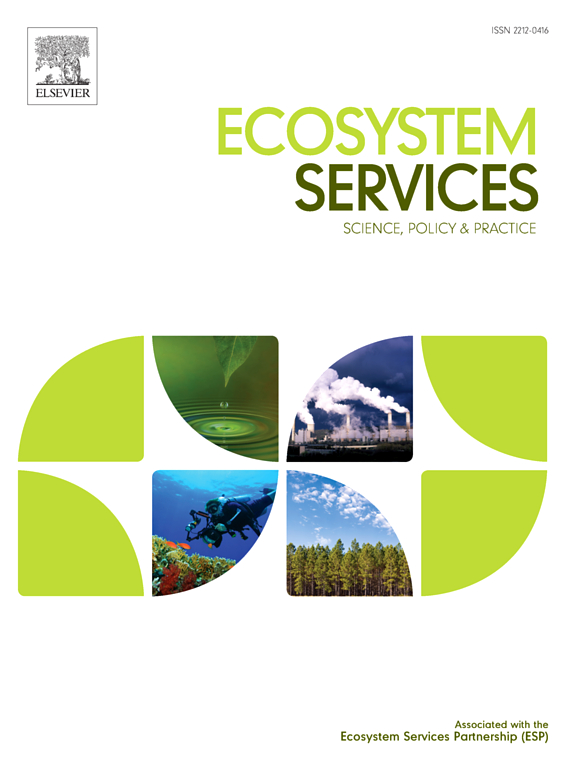Mapping emergent costs and benefits of ecosystem service flows in Senegal’s small-scale fishery supply chain
IF 6.6
2区 环境科学与生态学
Q1 ECOLOGY
引用次数: 0
Abstract
This research aims to model and map flows of ecosystem contributions to society across distances and spatial scales in a marine social-ecological system (SES). We spatially assess Ecosystem Service (ES) flows from small-scale fisheries by considering environmental costs and benefits emerging across the fisheries supply chain, and by investigating the role and contributions of intermediaries from the point of supply up to reception of the final benefit. While the existing literature on fisheries SES has predominantly focused on either the supply or demand side, in limited cases researchers examine flows by considering their spatial attributes across different spatial scales. We address this gap by defining benefit flows within the fisheries SES through the development of an ES flow index, integrating socioeconomic and environmental system attributes. Also, geographical accessibility is embedded in the index to account for access to resources, i.e. the ability to benefit from things. ES flow is assessed through plural costs and benefits emerging across intermediate activities of the supply chain. Costs are assessed as carbon emissions from catching, processing, and transportation, while benefits are those accruing to beneficiaries through nutritional benefits to jobs generated. All data and the final index are developed in a spatially explicit manner which allows for visualizing the flow of ES to both adjacent and distant to the supplying ecosystem, beneficiaries. The maps reveal distinct patterns for coastal regions compared to the regions that receive benefits away from the coast, indicating a spatial variability with a dependence on the distance from the providing ecosystem. The results of the study have implications for understanding how access to marine natural resources can impact regional beneficiaries, while revealing potential ES supply-flow and flow-demand mismatches in the distribution of marine resources, particularly in areas with communities in need and limited infrastructure.

绘制塞内加尔小规模渔业供应链生态系统服务流动的紧急成本和效益
本研究旨在建立海洋社会-生态系统(SES)中不同距离和空间尺度的生态系统对社会贡献流的模型和地图。我们通过考虑整个渔业供应链中出现的环境成本和效益,并通过调查从供应点到最终收益的中介机构的作用和贡献,在空间上评估了小规模渔业的生态系统服务(ES)流动。虽然现有的渔业SES文献主要集中在供给或需求方面,但在有限的情况下,研究人员通过考虑不同空间尺度的空间属性来研究流量。我们通过制定综合社会经济和环境系统属性的社会经济系统流量指数来定义渔业社会经济系统内的利益流动,从而解决了这一差距。此外,地理可及性被嵌入到索引中,以说明获取资源的能力,即从事物中受益的能力。通过供应链中间活动中出现的多重成本和收益来评估ES流。成本被评估为捕捞、加工和运输过程中的碳排放,而收益则是通过营养效益和创造的就业机会给受益人带来的收益。所有数据和最终指数都以空间明确的方式开发,从而可以可视化ES流向邻近和远离供应生态系统的受益者。与远离海岸的地区相比,这些地图揭示了沿海地区的不同模式,表明了与提供生态系统的距离相关的空间变异性。这项研究的结果有助于理解获取海洋自然资源如何影响区域受益者,同时揭示海洋资源分布中潜在的ES供需不匹配,特别是在有需求的社区和基础设施有限的地区。
本文章由计算机程序翻译,如有差异,请以英文原文为准。
求助全文
约1分钟内获得全文
求助全文
来源期刊

Ecosystem Services
ECOLOGYENVIRONMENTAL SCIENCES&-ENVIRONMENTAL SCIENCES
CiteScore
14.90
自引率
7.90%
发文量
109
期刊介绍:
Ecosystem Services is an international, interdisciplinary journal that is associated with the Ecosystem Services Partnership (ESP). The journal is dedicated to exploring the science, policy, and practice related to ecosystem services, which are the various ways in which ecosystems contribute to human well-being, both directly and indirectly.
Ecosystem Services contributes to the broader goal of ensuring that the benefits of ecosystems are recognized, valued, and sustainably managed for the well-being of current and future generations. The journal serves as a platform for scholars, practitioners, policymakers, and other stakeholders to share their findings and insights, fostering collaboration and innovation in the field of ecosystem services.
 求助内容:
求助内容: 应助结果提醒方式:
应助结果提醒方式:


